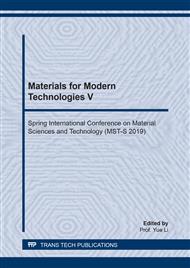[1]
C. Namasivayam , D. Kavitha, Removal of Congo Red from water by adsorption onto activated carbon prepared from coir pith, an agricultural solid waste, Dyes Pigments. 54 (2002) 47-58.
DOI: 10.1016/s0143-7208(02)00025-6
Google Scholar
[2]
N.M. Mahmoodi , M.J. Arami, Degradation and toxicity reduction of textile wastewater using immobilized titania nanophotocatalysis, J Photochem Photobio B. 94 (2009) 20-24.
DOI: 10.1016/j.jphotobiol.2008.09.004
Google Scholar
[3]
L.G. Devi, K.E. Rajashekhar, K.S.A. Raju, S.G. Kumar, A kinetic modeling based on the nonlinear regression analysis for the degradation of the Alizarin Red S by advaanced photo Fenton process using zero Valent metallic iron as the catalyst, J Mol Catal A-Chem. 314 (2009) 88-94.
DOI: 10.1016/j.molcata.2009.08.021
Google Scholar
[4]
B.A. Ahmad, M. Chirangano, Mechanisms of Alizarin Red S and Methylene blue biosorption onto olive stone by-product: Isotherm study in single and binary systems, Ceramics International. 43 (2017 )556-563.
DOI: 10.1016/j.jenvman.2015.08.040
Google Scholar
[5]
M. Thamima, Y. Andou, S. Karuppuchamy, Microwave assisted synthesis of perovskite structured BaTiO3 nanospheres via peroxo route for photocatalytic applications, J Environ Manage. 164 (2015) 86-93.
DOI: 10.1016/j.ceramint.2016.09.194
Google Scholar
[6]
M. Panizza, M.A. Oturan, Degradation of Alizarin Red by electro-Fenton process using a graphite-felt cathode. Electrochim Acta. 56 (2011) 7084-7087.
DOI: 10.1016/j.electacta.2011.05.105
Google Scholar
[7]
J. Gao, J. Yu, Q.F. Lu, X.Y. He, Y. Wu, Y. Li, L.M. Pu, Z.M. Yang, Decoloration of alizarin red S in aqueous solution by glow discharge electrolysis, Dyes Pigments. 76 (2008)47-52.
DOI: 10.1016/j.dyepig.2006.08.033
Google Scholar
[8]
S.S. Shinde, C.H. Bhosale, K.Y. Rajpure, Hydroxyl radical's role in the remediation of wastewater, J Photoch Photobio B. 116 (2012) 66-74.
DOI: 10.1016/j.jphotobiol.2012.08.003
Google Scholar
[9]
M.D. Bai, X.Y. Bai, Z.T. Zhang, M.D. Bai, B. Yang, Treatment of Red Tide in Ocean Using Non-Thermal Plasma Based Advanced Oxidation Technology, Plasma Chem Plasma P. 25 (2005) 539-550.
DOI: 10.1007/s11090-004-4998-2
Google Scholar
[10]
K.M. Lee, S.B.A. Bee, C.W. Lai, Multivariate analysis of photocatalytic-mineralization of Eriochrome Black T dye using ZnO catalyst and UV irradiation, Mater Sci Semicond Process. 39 (2015) 40-48.
DOI: 10.1016/j.mssp.2015.03.056
Google Scholar
[11]
J. Zhang, M.Y. Feng, Y.C. Jiang, M.C. Hu, S.N. Li, Q.G. Zhai, Efficient decolorization/ degradation of aqueous azo dyes using buffered H2O2 oxidation catalyzed by a dosage below ppm level of chloroperoxidase, Chem Eng J. 191 (2012) 236-242.
DOI: 10.1016/j.cej.2012.03.009
Google Scholar


